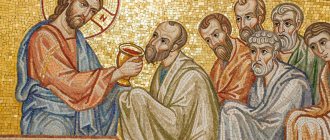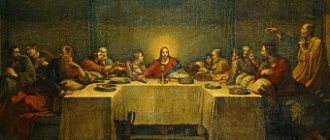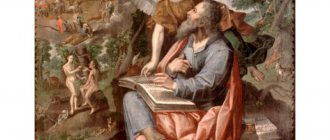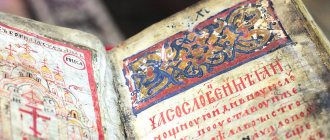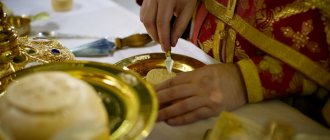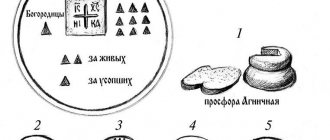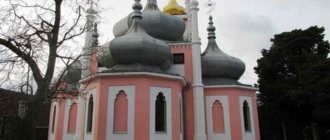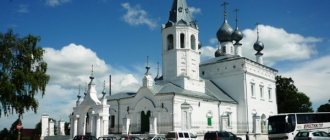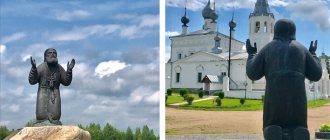The actions of the prayers of church ministers and believers, the mysterious presence of God, the Most Holy Theotokos, and angels at the divine liturgy of John Chrysostom in the text with explanations make it possible to understand the meaning of the service being performed.
The meaning of the word “liturgy” means “common service”
The meaning of the word “liturgy” means “general service,” that is, the participation of the maximum number of church parishioners and clergy in worship. In which a believer has the opportunity to unite with the Lord through the sacrament of the Eucharist (Communion).
Origin of the Divine Liturgy
The origin of the main church service comes directly from our Lord Jesus Christ Himself. During his ministry on Earth, He introduced the apostles to Communion at the Last Supper. The prayer order of the liturgy was established in apostolic times. At the beginning of the 4th century, the liturgy of St. Basil the Great was compiled, and a little later, John Chrysostom, somewhat shortening the prayers, reduced the duration of the liturgy.
The Liturgy of John Chrysostom in the text with explanations is divided into three main stages
The Liturgy of John Chrysostom in the text with explanations is divided into three main stages. At the beginning of the service, through the prayers of the priest and believers, the Holy Gifts are prepared, in the middle of the liturgy, Orthodox Christians prepare themselves for their reception through the sacrament of confession, and at the end of the service, through the prayers of the priest, the sacrament of the Eucharist is celebrated.
Every action of the priest is in tune with the earthly life of Jesus Christ. Proskomedia is a symbol of His birth, the small entrance is His missionary preaching activity, the great entrance is the entry of the Lord into Jerusalem. When “take, eat” is said, the curtain closes on the altar, symbolizing the death of Christ.
The communion of the clergy signifies the Resurrection of Christ, the removal of the cup from the altar is performed in memory of the appearance of the resurrected Mission to the people, when the cup is returned to the altar it is a symbol of the ascension of the Savior to the Throne of God.
No. 15 SUMMARY OF THE DIVINE LITURGY OF ST. JOHN CHRYSOSTOM (rites and symbolism)
In our world, in which there is so much evil and injustice, God came two thousand years ago and became a Man. He came to save us from evil, from loneliness, from the death of the soul. When, after His death on the cross, His disciples gathered together, He, having risen from the dead, came to them, talked and even ate with them. He continues to come to us in our days when we gather together for the Divine Liturgy.
The Divine Liturgy (from the Greek - “common cause”) is the main public service, during which the Great Sacrament of the Church is celebrated - the Sacrament of Communion or the Eucharist (from the Greek - “thanksgiving”). By participating in this Sacrament, Christians thank God for the gift of life, for the forgiveness of sins, for all the joys and sorrows sent down by the Providence of God. Our Lord Jesus Christ performed the first Liturgy in the Upper Room of Zion at the Last Supper, and each Liturgy is a mysterious continuation of this event. Believers gather in church in order to glorify God together “with one mouth and one heart” and partake of the Holy Mysteries of Christ. Before the start of the liturgy, the priest and deacon perform entrance prayers in front of the Royal Doors. Then, having asked each other and the people for forgiveness, they enter the St. Altar and applied to St. The Throne, the Gospel and the Cross. After this, they put on holy vestments and read the appropriate prayers. The Liturgy can be divided into three main parts:
I. PROSKOMIDIA (from Greek - “bringing”, “offering”) During this part, liturgical bread (prosphora) and wine for the Eucharist are prepared; the names of the Mother of God, saints and Christians (living and deceased) are remembered, for whom the priest in the Altar on the altar takes out particles from the prosphora. Therefore, everyone who is present in the church at this time should send a memorial for the health and repose of their Orthodox relatives and friends. • In the church, usually at this time the reader reads a special prayer - the Hours (3rd and 6th hour), as well as the procedure for Holy Communion. While reading the Hours, we are called to remember the trial of Christ by Pilate, His humiliation and beating, how He was led to Golgotha, how He was crucified on the Cross, how darkness fell over the whole earth (Luke 23:44) , etc. • Before the start of the Liturgy, a priest or deacon with a censer censes the Altar, the clergy and all those praying in the church. Incense smoke symbolizes the action of the Holy Spirit, filling the temple with God's grace, sanctifying the believers.
II. LITURGY OF THE CAMITELLES present at this part of the Liturgy , i.e. those people who are preparing to receive Holy Baptism and receive instruction (catechumen) in the Christian faith. • Deacon: “Bless, master . The Liturgy begins with the exclamation of the priest glorifying the Kingdom of the Holy Trinity - the Kingdom of peace, truth and Light, which Christ brought to earth: “Blessed is the Kingdom of the Father, and the Son, and the Holy Spirit, now and ever, and unto the ages of ages.” . Doxology is the highest form of prayer, in which a person seems to forget himself and directs all the forces of his soul to praise and glorify the Creator. Having heard the initial blessing pronounced by the priest, the church community, on whose behalf the choir acts, joins in glorifying the Kingdom of God by singing “Amen” , which means “truly so.” • The deacon (or priest) proclaims a peaceful or great litany (from the Greek - “protracted prayer”), calling on all Christians in the world with God and their neighbors to pray for the salvation of souls, for peace, for the Church, for the temple, for those who pray, for The Patriarch, about the ruling bishop, about the clergy, about the clergy, about the Fatherland, about the authorities, about the army, about all believers, about the fertility of the earth, about travelers, about the suffering, about the captives, about deliverance from sorrows and the complete entrustment of oneself and one’s life to God - 11 requests in total. The peaceful litany ends with the exclamation of the priest: “For due to You is all glory, honor and worship, to the Father and the Son and the Holy Spirit, now and ever and unto the ages of ages . Chorus: "Amen" . • Next, the choir sings the 1st antiphon (from the Greek - “echoing”): “Bless the Lord, my soul...” - these are selected verses of Psalm 102. The first antiphon calls believers to the inner heartfelt glorification of God, according to the words of the holy Apostle Paul, who commanded Christians to believe in the truth of God with their hearts, and to confess God with their lips for their salvation. The deacon performs the small litany: “Back and back (again and again) let us pray to the Lord in peace...” . Priest: “For Yours is the dominion, and Yours is the Kingdom, and the power, and the glory, of the Father and the Son and the Holy Spirit, now and ever and unto ages of ages . Chorus: "Amen." • Then the choir sings the 2nd antiphon : “Praise my soul the Lord...” (Psalm 145). In the second antiphon, Christians are called to confess God not only with their lips, but with their whole lives. And rely only on God, and not on people, even those with power and wealth. This antiphon ends with the hymn to Jesus Christ “Only Begotten Son...” , in which we ask Christ to save us. It also reveals the teaching about the Savior as God incarnate from the Virgin Mary and about the salvation of the human race through His atoning death on the Cross and Resurrection. Deacon: “Let us pray again and again in peace to the Lord...” . Priest: “For Thou art a Good and Lover of Mankind, and to Thee we ascribe glory: to the Father, and to the Son, and to the Holy Spirit, now and ever, and unto the ages of ages . Choir: "Amen" . • During the singing of the third antiphon “in Thy Kingdom, remember us, Lord...” - the 9 Beatitudes taught by Jesus Christ in the Sermon on the Mount (Matthew 5:1-7:29; Luke 6:12-41), is performed Small Entrance with the Gospel, which symbolizes the entrance of Christ the Savior to preach about the Kingdom of God and Repentance. The candlebearer with a candle, walking in front of the deacon, signifies the light of New Testament grace. The Gospel carried by the deacon means Christ the Savior, the priest reveals the image of the holy apostles. At the Royal Doors, the deacon makes the sign of the Cross with the Gospel and enters the Altar . This symbolizes that through the suffering of the Savior on the cross, the entrance to the Kingdom of Heaven is opened to all believers. And the deacon’s exclamation “Wisdom, forgive” is a call to believers to heed the wisdom of God, standing reverently. If it’s Sunday, then the choir sings: “Come, let us worship and fall before Christ. Save us, Son of God, risen from the dead, singing to you: Hallelujah . If it is the Mother of God holiday, then instead of “Risen from the Dead” they sing “Prayers of the Mother of God” . If it is the memory of a saint, then – “He is wondrous in the saints . • Next, the choir, alternating with the clergy, sings troparia and kontakia, which reflect the meaning of the holiday of a given Sunday or the memory of a saint. Deacon: . ” Priest: “For You are holy, our God, and to You we send glory, to the Father and the Son and the Holy Spirit, now and ever . The deacon alternates with the choir: “Lord, save the pious...”; “...And hear us.” Deacon: “...And forever and ever . Choir: "Amen" . The choir sings: “ Holy God, Holy Mighty, Holy Immortal, have mercy on us . (3 times). This prayer is called the Trisagion , and represents the angelic singing (doxology) of the Seraphim before the Throne of the Lord of Hosts in the vision of the prophet Isaiah (Isaiah 6:3) with the names of the persons of the Most Holy Trinity and with a petition for mercy on us sinners. During the singing of the Trisagion, the priest in the Altar stands in the High Place, behind the Throne, facing the people. (This means the completion of the salvation of the entire human race by Christ the Savior and His ascension into the Kingdom of Heaven to God the Father). Then passages from the Apostle and the Gospel are read . • Reading the book of the Apostle reminds us of the preaching of the holy apostles. Believers prepare for the careful reading of the Apostle by shouting: “Let us listen” (let us listen!). • Reading the Gospel – the preaching of Christ Himself. In some churches, after reading the Gospel, the priest delivers a sermon. • After the Gospel and the sermon, the deacon performs a special (intensified) litany for the health and salvation of all believers with the exclamation of the priest: “For you are a merciful and lover of mankind, and we send glory to you, to the Father and the Son and the Holy Spirit, now and ever and ever.” eki centuries" . Chorus: "Amen" . • Then the funeral litany with the exclamation - “For You are the Resurrection and the Life (life), and the rest of Your departed servants (names), Christ our God, and we send glory to You, with Your Beginning Father Your Most Holy and Good and Life-Giving Spirit, now and ever and unto ages of ages . Choir: “Amen” , in which we commemorate the departed Orthodox Christians. litanies follow : the first is about the catechumens , i.e. about those who are preparing for the Sacrament of Baptism (sometimes it is omitted). The next two are about the faithful , i.e. about believers who have received Baptism. At the end of the third litany, the priest pronounces the exclamation: “As we always keep under Your power, we send glory to You, to the Father and the Son and the Holy Spirit, now and ever and unto the ages of ages . The choir sings a drawn-out: “Amen .
III. LITURGY OF THE FAITHFUL This is the name of the third part of the Liturgy , because only the faithful can attend it, i.e. baptized and churched. After the command to the catechumens to leave the Temple - “ Elites (from Greek - “those who”) the catechumens go out... ”, the Cherubic Hymn . This chant calls on believers to leave all thoughts about everyday problems and become like the Cherubim, who are near God in Heaven, singing the Trisagion with them. During the singing in the Altar, the priest says: “Even though the Cherubim secretly form the Trisagion hymn to the Life-giving Trinity, let us now put aside all worldly cares.” . Deacon: “Let us raise up the King of all, invisibly angelic Dorinosima Chinmi. Alleluia, alleluia, alleluia." In Russian: “We, mysteriously becoming like the Cherubim and chanting the Trisagion hymn to the Trinity, which gives life, will now leave the concern for all everyday things, so that we can glorify the King of all, Whom the invisibly angelic ranks solemnly glorify. Praise be to God." (3 times). • After the choir sings the words: “Let us now put aside every care of this life...” the priest and deacon solemnly carry out the Holy Spirit. Chalice and Paten (from Greek - “round dish”) with wine and bread prepared for the Eucharist from the northern doors of the Altar. Stopping at the solea, facing the people, the clergy proclaims a prayer for the hierarchy and for everyone whom we especially remember: the brethren of the temple, parishioners, the sick, singers, benefactors, etc. Then, through the Royal Doors, the clergy enters the Altar and delivers St. Chalice and Paten for St. Throne. The Great Entrance marks the solemn procession of Jesus Christ to free suffering and death on the cross. The choir ends the Cherubic Hymn with the words “For the King we will raise everyone up...” . • After the “Cherubim”, the deacon pronounces the petitionary litany “Let us fulfill our prayer to the Lord...” , which ends with the exclamation of the priest: “By the generosity of Thy Only Begotten Son, with Him art Thou blessed, with Thy Most Holy and Good and Life-Giving One by the Spirit, now and forever, and to the ages of ages ..." . Chorus: "Amen" . Priest: “Peace to all.” Choir: . ” Deacon: “Let us love one another, that we may confess with one mind . Choir: “Father and Son and Holy Spirit, Trinity Consubstantial and Indivisible . At this time, in the Altar, the priests kiss the Sacred Vessels covered with Air and each other’s shoulders with the words: “Christ is in the midst of us - is and will be . The same action can be performed by believers standing nearby in the temple, as was customary in the Ancient Church. After the deacon’s exclamation: “Doors, doors, let us enter into wisdom,” all the parishioners standing in the church begin singing the “Creed” This exclamation of the deacon can be understood as a call to close the doors of your heart to everything extraneous, vain, sinful, and to concentrate entirely on the upcoming sacred rite in order to be imbued with the highest wisdom during the celebration of the Sacrament of Christ’s Sacrifice for us, the unworthy. • The Creed includes 12 main dogmas or Divine Truths about the Orthodox faith, which were approved by the Holy Fathers at the First Ecumenical Council in Nicaea (325) and the Second in Constantinople (381). The Orthodox Church has preserved them in purity from heresies to this day. • Next comes the main part of the Liturgy - the Eucharistic Canon , at which the Holy Sacrament of the Eucharist is performed - the transformation of bread and wine into the True Body and True Blood of our Lord Jesus Christ. Deacon: “let us become kind, let us stand with fear, let us offer holy offerings in the world” (i.e., the time has come for the Sacrament, which must be approached with a peaceful heart). Chorus: “Mercy of peace, sacrifice of praise” (i.e., we will offer a sacrifice that would reconcile us with God, and we thank Him with deeds of love and mercy). Priest (addressing the people): “The grace of our Lord Jesus Christ, and the love (love) of God and the Father, and the communion (communion) of the Holy Spirit, be with you all . This is a wish for believers today to be rewarded with the saving power of Christ, the love of the Heavenly Father and cleansing from the Holy Spirit. Chorus: “And with your spirit . Priest: “We have hearts of grief (to God) . Choir: “ Imams to the Lord (we give ourselves all to the Lord).” Priest: . ” Chorus: “It is worthy and righteous to worship the Father and the Son and the Holy Spirit, the Trinity, Consubstantial and Indivisible . In the Altar, the priest secretly pronounces Eucharistic (thanksgiving) prayers to God for the creation and redemption of people, for His great mercies and patience towards us sinners. Priest: “Singing the song of victory, crying out, calling out and saying . At the exclamation of the priest, the choir sings: “Holy, holy, holy is the Lord of hosts...” . These words are reminiscent of the vision of the viewer of the ineffable Mysteries of God by the Apostle John the Theologian, who saw at the Throne of God four animals like an eagle, a calf, a lion and a man, who “neither day nor night have peace, crying out: “ holy, holy, holy is the Lord God Almighty, who was, is and is to come” (Rev. 4.6-8.) A solemn song sounds: “Holy, holy, holy is the Lord of hosts, the heavens and the earth are filled with Your glory; Hosanna (Heb. - save, help God) in the highest (in Heaven) , blessed is He who comes (He who comes) in the name (for the glory) of the Lord, Hosanna in the highest . With the words of the 2nd part of this hymn we met the Lord at Entry into Jerusalem on a donkey. The priest, while singing, performs secret prayers, then, pointing to the Paten, proclaims: “ Take and eat this (this) is My Body, is broken (broken ) for you for the remission (forgiveness) . ” Chorus: "Amen" . The priest, pointing to the Cup, proclaims: “Drink of it, all of you, this (this) is My Blood of the New Testament, which for you and for many (for many people) . ” Chorus: "Amen" . The priest proclaims: “ Yours from Yours, offered to You, for everyone and for everything . (i.e. Your Gifts, O God, are offered by Your servants, as a propitiatory and grateful sacrifice from all of us, for everything You have done for the atonement of our sins and our salvation). And he makes the offering of the Paten and the Chalice. • While singing in chorus: “We sing to You, we bless You, we thank You, Lord, and we pray to You, our God ,” each of us is called to remember: - the countless mercies that we receive in abundance from the hands of God throughout our lives ; - His wonderful mercy towards us and His long-suffering of us, almost always of little faith, fickle and ungrateful; - His unshakable love for us who are disobedient, who offend Him in word, in deed, in thought; - betraying Him with their infidelity, with their countless obvious and secret sins; - always looking for a reason to refuse His invitation to share with Him the divine meal in the sacrament of the Holy Eucharist. Therefore, covered with shame and repentance on our knees, let us exclaim in our minds: “We sing to You. We thank you, Lord, we pray to you, our God . At this time, the priest at the Throne performs epiclesis (from the Greek - “invocation”), i.e. a prayer for the condescension of the Holy Spirit on the offered Gifts and on the upcoming people, so that He would sanctify them. • Then the priest with raised hands in a low voice reads the prayer: “Lord, Who sent down Thy Most Holy Spirit at the third hour by Thy Apostle, Thou who art good, do not take it away from us, but renew us who pray to Thee” (3 times). And the deacon pronounces the 12th and 13th verses of the 50th psalm of repentance: “Create a pure heart in me, O God, and renew a right spirit in my womb”; “Do not cast me away from Your presence, and do not take Your Holy Spirit from me.” In conclusion, the priest performs secret sacred rites, as a result of which the Holy Spirit transforms the Bread on the Paten into the Body of Christ , and the Wine into the Blood of Christ . Everyone in the Altar bows to the ground before the Holy Gifts as to the King and God Himself . This is the most important moment of the Liturgy. In the temple, all those praying during this singing kneel. • The Eucharistic canon ends with the exclamation of the priest: “Fairly (especially) about the Most Holy, Most Pure, Most Blessed, Glorious Our Lady Theotokos and Ever-Virgin Mary” and the choir singing a song of praise to the Mother of God “It is worthy to eat, for it is truly blessed come to Thee, Mother of God, ever-blessed and most immaculate and Mother of our God . The most honorable Cherub and the most glorious without comparison Seraphim, without the corruption of God the Word, who gave birth to the real Mother of God, we magnify Thee . (Everyone in the temple rises from their knees). And the priest addresses the saints of a given liturgical day according to the month, and prays for living and departed Christians and for many other blessings of God. • After the priest’s exclamations: “First remember, Lord...”; “And give us one mouth and one heart...”; “And may the mercies of the great God and our Savior Jesus Christ be with you all” - the deacon performs a petitionary litany “All the saints who have been remembered...”, “for the offered and consecrated Honest Gifts let us pray to the Lord...” . At the Liturgy we participate in the closest communion with all the saints, so we again remember them as our closest intercessors before God and especially pray for the consecrated Gifts. • After the exclamation of the priest: “And grant us, Master, with boldness, without condemnation, to call upon You, the Heavenly God of the Father, and say...” the deacon and the people sing the Lord’s Prayer “Our Father...” . Every Christian should not only know this prayer by heart, but also understand what it says. The singing ends with the exclamation of the priest: “For Thine is the Kingdom, and the power, and the glory of the Father and the Son and the Holy Spirit, now and ever and unto the ages of ages . Chorus: "Amen." Priest: “Peace to all.” Chorus: “And to your spirit.” Deacon: “Bow your heads to the Lord . Chorus: “For you, Lord.” Priest: “ By the grace and generosity and love of mankind of your only begotten Son, with whom art thou blessed, with Thy Most Holy and Good and Life-giving Spirit, now and ever, and unto the ages of ages” . The chorus drawls: “Amen . The deacon drawled: . ” The Royal Doors are closing. • The Priest in the Altar, lifting up the Holy Lamb , proclaims . ” This exclamation means that Holy Communion is intended for those Christians who strive for spiritual perfection and are zealous about pleasing themselves to God, the transformation and salvation of their soul. In the Altar, after this, prayers and sacred rites are performed for the communion of the clergy and people. At this time, the choir sings festive chants, after which prayers for Holy Communion . • Then the royal doors open, the deacon proclaims, “Come with the fear of God and faith!” and brings out the Chalice with the Holy Gifts, and the priest says the prayer of St. John Chrysostom: “I believe, Lord, and confess that You are truly the Christ, the Son of the Living God...” (every communicant must know this prayer by heart). First the children, then the men, and after them the women come up to receive the Holy Mysteries of Christ, and all the people sing: “Receive the Body of Christ, / Taste the immortal Fountain . • After Communion, the particles taken from the prosphora at Proskomedia are immersed by the priest on the Throne from the paten into the Holy Chalice with the words: “Wash away, Lord, the sins of those remembered here by Your Honest Blood, by the prayers of Your saints . According to the Gift of Christ and according to the Faith of the Holy Church, many sins of the living and the dead are forgiven by the Savior who loves us. However, for living Christians, this Grace of Christ cannot replace personal repentance (the Sacrament of Confession). • After this, the priest blesses the people with the exclamation: “Save, O God, Thy people, and bless Thy inheritance . Then, holding the Chalice with the Holy Gifts in his hands, he proclaims in the Royal Doors: “always, now and ever and to the ages of ages” and takes the Holy Gifts to the Altar with the words: “Ascend into heaven, O God, and throughout all the earth is Your glory . With this we remember the Ascension of the Lord Jesus Christ into the Heavenly Kingdom, His constant presence with believers on earth in the Sacraments of the Church and His future glorious Second Coming. The choir sings: “We have seen the true light, received the Heavenly Spirit...” , and also “May our lips be filled with praise of Thy Lord...” . • At the end of the Liturgy, the deacon proclaims a litany of thanksgiving for receiving the Communion of the Body and Blood of Christ, . ” This litany ends with the exclamation of the priest: “For You are our sanctification, and we ascribe glory to You, Father, and Son, and Holy Spirit, now and forever, and to the ages of ages” and the prayer behind the pulpit: “Bless those who bless You , Lord, and sanctify on You who trust, save Your people and bless Your heritage...” • After the dismissal of the Liturgy, at which the priest remembers our Lord Jesus Christ, the Most Holy Theotokos, the saints of the temple and the saints of the day, the choir sings for many years and a sermon is delivered. Then all the believers venerate the cross, and the communicants listen to prayers of thanksgiving for Holy Communion and go to their homes, trying not to lose the received grace of God in vain affairs, using the remaining time of the day to do good deeds and stay with God in prayer.
In conclusion, it should be noted that everything presented in this publication is only the visible and audible form of the Liturgy. Much is hidden from those praying, especially regarding secret prayers and sacred rites performed by the priest in the Altar of St. Altar and St. Throne. All these prayers are graciously linked into one jubilant and grateful song to Christ the Savior. And for a believing Christian, the Liturgy proceeds “in one breath,” since he no longer feels himself on earth, but in the joyful Kingdom of Heaven! The Liturgy unites us with Christ and connects us with our Heavenly Fatherland. And, if through the Liturgy we love Him here on earth, then we will find Him in Eternity. In conclusion, it should be noted that the Liturgy is an integral part of the All-Night Vigil, which cannot be missed, especially for those who wish to partake of the Holy Mysteries of Christ.
Development of the liturgical order
A text explaining the liturgy of John Chrysostom will help to understand the development of the liturgical order.
The liturgy begins with a proskomedia or offering. This offering is specially baked bread called prosphora and wine, which at the end of the service mysteriously, through the prayer of the priest, become the Holy Gifts (the Body and Blood of Jesus Christ).
The liturgy begins with a proskomedia or offering
There should be five such prosphoras. Four is the image of the evangelists, and the fifth is the Lord himself. The priest carefully removes the particles from them with a special copy. From the 1st loaf, remembering Christ, from the 2nd - the Most Holy Theotokos, from the 3rd - in honor of the holy saints, from the 4th, remembering the names of the living, and from the 5th, deceased Christians. Through these actions the structure of the spiritual and earthly world is presented. This stage of the divine liturgy is performed in a mysterious way, with the doors of the altar closed.
The middle of the service refers to the Liturgy of the Catechumens. These are people preparing to become Christians through the sacrament of Baptism. It begins with the words: bless, Master.
The middle of the service refers to the Liturgy of the Catechumens
After this, prolonged prayers are performed. This part of the service is called litany. With the words “let us pray to the Lord in peace,” the Great Litany begins. The choir is an active participant in the divine liturgy. The thanksgiving antiphon “Bless the Lord, my soul,” is sung, with which the Great Etiny ends.
With the words “again and again (again and again) let us pray in peace to the Lord” and the laudatory antiphon “Praise the Lord, my soul,” the Small Litany begins, which resembles the Beatitudes. With the reading of passages from the Gospel and the Apostle, the small litany ends and with the words “saying (let’s say) everything with all our soul, and with all our thoughts reciting,” a special petition begins. In it they ask the Lord for mercy for the ministers of the Church and those in power who have secular authorities.
With the words “let us pray to the Lord in peace,” the Great Litany begins
The prayer petitions end with the litany of the catechumens: “Pray the catechumens to the Lord.” The priest prays that the Lord will reveal to them the light of the Gospel and unite them with the Church of Christ. Next, the priest asks the catechumens to leave the temple: catechumens, go away. Since they are not yet full members of the Church, they cannot receive the Holy Gifts.
After this, with the words “intercede, save, have mercy and preserve us, O God, by Your grace,” the last stage of the liturgy begins, called the liturgy of the faithful, that is, baptized believers. On it, parishioners offer up the prayers “Creed” and “Our Father” together.
The priest, while prayers are being performed, accepts the confession of those who wish
The priest, while prayers are being performed, accepts the confession of those who wish and blesses the people to receive the Holy Gifts. It is important to know that you cannot approach Communion without the sacrament of confession. Also preparing for it, the day before, the preparatory prayer rule for Holy Communion is read.
The Eucharist begins with the words of the priest: “I believe, Lord, and I confess.” Those preparing for the sacrament of the Eucharist reverently and tremblingly approach the Chalice, folding their hands on their chest in a cross, the right hand should be on top of the left. When those wishing to receive communion approached the Chalice, the priest, praying “Illuminate yourself with light, be illuminated,” takes the Chalice to the altar and there he receives the Holy Gifts. After Communion, parishioners read prayers of thanksgiving.
With the prayer “Lord, who blesses those who glorify,” the priest allows you to leave the temple, and with the words “Christ, our true God,” he concludes the entire divine liturgy.
Next, the priest gives a short sermon and gives a blessing to the parishioners. They approach him, venerate the cross and receive pieces of antidor (prosphora) and quietly thank God for the great grace of being with Him at the Divine Liturgy.
Proskomedia (performed in the altar). Reading the clock. (s – priest, d – deacon, k – choir, choir)
Censer (to the altar at the end of the proskomedia)
TURN ON LIGHTS (chandelier)
OPEN THE CURTAIN (at the beginning of 6 o'clock)
Censer (for censing the altar and temple) d - Bless, master. c- Blessed is the Kingdom... d- Great Litany (peaceful): Let us pray to the Lord in peace... c- For all glory and honor are due to You... (exclamation) j- 1st antiphon: Bless the Lord, my soul... d- Small Litany: Packs and again... c- For Your power... j- 2nd antiphon: Praise, my soul, the Lord... j- Only Begotten Son... LIGHT THE CANDLE d- Small Litany: Packs and packs... c- For Thou art a Good and Lover of Mankind...
OPEN THE ROYAL GATES
Censer (if 2 deacons) to - 3rd antiphon (Blessed). SMALL ENTRANCE (with the Gospel) EXIT WITH A CANDLE d- Wisdom, forgive me! j- Entrance: Come, let us worship and fall before Christ... j- Troparion and kontakion of the holiday and the temple. c- For You are Holy, our God, and we send glory to You... d- Lord, save the pious and hear us. k- Trisagion. EXIT WITH THE APOSTLE to the Glory Censer (to the High Place) after Wisdom 1st time. Prokeimenon. LIGHT THE CANDLE READING THE APOSTLE Alleluia. TAKE THE LANDWAY OUT WITH THE CANDLE d - READING THE GOSPEL . REMOVE THE LEATHER SUBMIT NOTES ABOUT HEALTH d- Litany of repose: With all my heart we sing... For you are merciful and lover of mankind... * If there is no funeral litany, then CLOSE THE GATES CENIS SUBMIT NOTES ABOUT RESTING d- Litany for the repose: Have mercy on us, O God, in your great mercy ... s- For You are the Resurrection and the belly and the rest of the departed...
CLOSE THE ROYAL GATES (if there is 1 deacon, if there are 2 deacons, then they will close themselves after the next litany)
1d- Litany about the catechumens: Pray for the catechumens, O Lord... s- Yes, and they too glorify the most honorable with us... d- The units of the catechumens, come forth... 2d- Litany: The units of the faithful, packs and packs d- Wisdom s- For all glory is due to You... 3d- Abbr. great ect: Packs and packs... d- Wisdom s- As if under Thy power...
OPEN THE ROYAL GATES
TURN ON THE LIGHTS (in the temple and in the altar) LIGHT THE CANDLES CENTER (2, if there are 2 or more deacons) to - Cherubic Hymn. GREAT ENTRANCE EXIT WITH CANDLE
CLOSE THE ROYAL GATES
CLOSE THE VEIL
TURN OFF THE LIGHTS (in the temple and in the altar)
d- Litany of Petition: Let us fulfill our prayer... with- The Generosity of the Only Begotten Son... with- Peace to all! d- Let us love each other... j- Father and Son and Holy Spirit... d- Doors, doors!..
OPEN THE VEIL
Symbol of faith
TURN ON THE LIGHT (in the temple and in the altar) d- Let us become kind, let us become fearful... j- The mercy of the world, the sacrifice of praise c- The grace of our Lord... j- And with your spirit. w- Woe are our hearts! j- Imams to the Lord. s- We thank the Lord! j- It is worthy and righteous to eat... c- Remember first, Lord... j- And everyone and everything. c- And give us one mouth... c- And may the mercies of the Great God be... j- And with your spirit. TURN OFF THE LIGHTS (in the temple and in the altar)
PRIESTS WASH HANDS d- Petitionary Litany: Having remembered all the saints... s- And grant us, O Master... Our Father, TO GIVE THE TEAP to the deacon s- For yours is the Kingdom... s- Peace to all. to - And to your spirit. d - Bow your heads to the Lord. to- You, Lord. c- Grace, and bounty... d- Let's remember. s-Holy to saints!
CLOSE THE VEIL
j- One is Holy, One is Lord... If there is no sermon LIGHT THE CANDLE and TAKE THE CANDLE OUT to- Involved. Communion of the clergy at the altar
OPEN THE VEIL
OPEN THE ROYAL GATES
d - Approach with the fear of God and faith. j- Blessed is He who comes in the Name of the Lord... c- I believe, O Lord, and I confess that You... Communion of the laity k- Receive the Body of Christ... j- Hallelujah THUMBS c- Save, O God, Thy people and bless... j- Videhom the True Light... c - Blessing: Always, now and ever... k- Let our lips be filled... d- Thanks. ect.: Forgive me, accept s- For You are our Sanctification... s- Let us depart in peace. k- About the name of the Lord. d - Let's pray to the Lord. k- Lord, have mercy. c- Prayer behind the pulpit: Blessing... j- Blessed be the Name of the Lord... j- I will bless the Lord... (Psalm 33) c- The blessing of the Lord is upon you... c- Glory to Thee, O Christ God... j- Glory even now. Lord have mercy. Bless. s- Great dismissal. k- Many years.
CLOSE THE ROYAL GATES
CLOSE THE VEIL
Brief outline of the Divine Liturgy
Analyzing the actions of the priest and the text with explanations, the liturgy of John Chrysostom becomes much clearer. A brief outline of the Divine Liturgy is as follows:
- stage 1 Proskomedia;
- Stage 2 Liturgy of the Catechumens;
- Stage 3 Liturgy of the Faithful;
- prayers after communion.
Next, the priest gives a short sermon and gives a blessing to the parishioners
Also, for a more detailed study of the text with explanations, the liturgy of John Chrysostom can be downloaded, printed, and by visiting the temple, remember the stages of the liturgical rite in practice.
About the Liturgy of St. Basil the Great
The Orthodox Church currently uses two complete Liturgies - St. Basil the Great and St. John Chrysostom. The names of these saints are primarily associated with the anaphora (from the Greek ἀναφορά - ascension) of both Liturgies. Anaphora is the main prayer that the priest reads to himself, in a quiet voice or sometimes quite loudly in the altar after the words: “We thank the Lord” - before the exclamation: “And may the mercies of the great God and our Savior Jesus Christ be with you all,” that is, in the time of the Eucharistic canon, as this segment of the service is now often called in common parlance. During this prayer, the transformation of bread and wine into the Body and Blood of Jesus Christ occurs.
Actually, speaking about the features of the Liturgies of St. Basil the Great and St. John Chrysostom, we are talking primarily about the anaphora and several more prayers, since there are very few differences in relation to the rite as a whole.
The first difference between the two Liturgies that strikes the eye is the greater duration and solemnity of the Liturgy of St. Basil. Its special status in worship is evident from the fact that, although today it is performed only ten times a year, it is celebrated on the most important days of the church year, from the eve of Christmas to Easter. This period, in the “edge” of the main holidays of the Christian world, is the most saturated with solemn services; it includes four more twelfth holidays, two ancient fasts - Great and Nativity - and Holy Week. The Liturgy of St. Basil is celebrated at Vespers on the most ancient holidays of the Nativity of Christ, Epiphany and Easter (in our time it is associated with the Liturgies of Christmas Eve and Holy Saturday, and in fact refers to the days of these holidays themselves); on the five Sundays of Great Lent, on Maundy Thursday - on the very day of the Last Supper and the establishment of the Sacrament of the Eucharist - as well as on the day of remembrance of St. Basil himself, January 1/14, which coincides with the Feast of the Circumcision of the Lord.
The Liturgy of St. Basil is known not only in the Orthodox world: its anaphora “(either explicitly - in one of its editions, or implicitly - in the form of its fragments used in other anaphoras) entered into the liturgical use of all Eastern Churches, and after the Second Vatican Council - and in the worship of Catholics of the Western Rite."
History and authorship of the Liturgy
There is a widespread opinion in the church community that the Liturgy of St. Basil appeared as a result of the shortening of the very long Liturgy of the Apostle James (supposedly out of mercy, for the sake of weakness and to facilitate the prayerful work of those present), and the Liturgy of St. John Chrysostom is a shortened Liturgy of St. Basil.
This theory was set forth in several church works and especially in the oldest and most authoritative treatise, which until the 20th century was attributed to St. Proclus of Constantinople, a disciple of St. John Chrysostom. However, in the 20th century, the liturgist F. Leroy managed to convincingly prove that this treatise is a forgery of the 16th century. So how then do the three most famous Liturgies in the Orthodox world actually relate to each other? Other researchers of the 20th century tried to answer this. We should start with a little-known fact to the general public: two main editions of the anaphora of St. Basil the Great have been preserved - short and lengthy - significantly different from each other. The extensive one - the one that is familiar to all of us - takes place in all Orthodox Churches; there are also Armenian and Syriac versions. The Short Edition, otherwise called the Egyptian, is the main Liturgy in the Coptic Church; its Greek and Ethiopian versions are also known. The lengthy edition arose on the basis of the short one as a result of its processing and significant additions.
In Western scholarship of the twentieth century, there was an opinion that Saint Basil was not the author of the prayers of the Liturgy and that he could only select the Eucharistic prayers that were known and widespread by that time, change or clarify some expressions in them. However, to date, a number of liturgists, through careful textual analysis and comparison of the anaphora of St. Basil with his other works, have convincingly proven that both its short and lengthy editions are the creation of the Great Saint himself.
At the same time, they all agree that Saint Basil could not completely leave aside the liturgical texts that were traditional in Cappadocia at the time of his accession to the see. Most likely, he radically edited the text of the ancient anaphora that existed before him, presumably the traditional anaphora of Caesarea of Cappadocia, where he was a bishop, adding large parts of prayer, many theological ideas, new theological terminology, etc.
Judging by the excerpt from St. Basil’s treatise “On the Holy Spirit,” in his time there was no solid, written anaphora:
“Which saint left us the words of invocation in the breaking of the bread of the Eucharist and the Cup of Blessing in writing? For we are not content with those words that the Apostle or the Gospel mentions, but both before them and after them we pronounce others, as having great power for the Sacrament, having received them from the unwritten teaching.”
The liturgical activity of the great saint is clearly indicated by the funeral oration, which was dedicated to him by his friend Saint Gregory of Nazianzus. When listing the virtues of the deceased, he mentions “ordering prayers” or “composing a sequence of prayers.” The connection of the Liturgy with the name of St. Basil in literature can be traced back to the 5th or 6th century. Around 543, Leontius of Byzantium wrote that already a century earlier the Liturgy of St. Basil and the Liturgy of the Apostles were in use in the Church of Constantinople.
In addition, the brief edition of the anaphora of St. Basil became the basis for the composition of the Liturgy, known as the Liturgy of the Apostle James, that is, the relationship between them is exactly the opposite than is usually thought.
A brief edition of the anaphora of St. Basil became the basis for the composition of the Liturgy, known as the Liturgy of the Apostle James
The anaphora of the Liturgy of St. John Chrysostom is textually in no way deducible from either one or the other Liturgy and is, apparently, the fruit of the independent authorial and editorial work of St. John on the ancient anaphora of the Twelve Apostles, which was preserved in the Antiochian Church.
It is interesting to note that in the service books until the 10th century, the Liturgy of St. Basil was placed before the Liturgy of St. John Chrysostom - in contrast to later and modern service books, where the Liturgy of Chrysostom comes first. This indicates that the Liturgy of St. Basil was the main Liturgy in Constantinople in the pre-iconoclastic era - qualitatively (it was used for more solemn worship on Sundays and on the most important days of the year) and, perhaps, quantitatively (that is, it was served more often than the Liturgy of St. John ), although the latter remains a guess. According to some signs, it can be assumed that it had an almost complete monopoly during the Easter cycle (Lent, Easter and Pentecost), and the Liturgy of St. John was served on the feasts of saints and in the period from Pentecost to Christmas. Perhaps we see echoes of this state of affairs in the current distribution of these two Liturgies.
The reasons for the change in the status of the two Liturgies after the 9th–11th centuries are not known for certain. Perhaps this happened precisely because of the brevity of the Liturgy of St. John Chrysostom against the background of “the spread of the practice of daily service of the Liturgy in Byzantine monasteries.”
Theological content of anaphora
If we give a brief definition of anaphora, we can characterize it as a prayer
- thanksgiving to God,
- remembrance of His benefits to man, including the Atonement and the gift of the Eucharist,
- requests to consecrate the Gifts and those receiving communion,
- intercession with God for different people.
The Anaphora of St. Basil “is distinguished by its theological accuracy and depth, which are combined with literary grace and the harmony of the text as a whole.” It is much longer than the same prayer in the Liturgy of St. John Chrysostom, so the choir uses longer chants so that the priest has time to read it.
The anaphora of St. Basil is addressed to God the Father and begins with this address:
“This (Existing) Master, Lord God, Father Almighty, worshiped!”
Next comes thanksgiving to God, which is structured in such a way as to reflect as many of the theological provisions of Revelation as possible, that is, what people know about God, and has a clearly expressed trinitarian structure (that is, each Person of the Holy Trinity is spoken of).
Thanks to God is structured in such a way as to reflect as many theological points as possible
The introduction sequentially describes each Person of the Most Holy Trinity using a chain of epithets taken mainly from the Holy Scriptures of the New and Old Testaments. It is known about Saint Basil the Great that he attached great importance to substantiating dogmas with references to Holy Scripture, therefore the abundance of quotations in the Liturgy is also accepted by scientists as one of the criteria for its belonging to the saint.
God the Father is given dominion over all creation, unknowability (“beginningless, invisible, incomprehensible...”) and Fatherhood. The latter allows the author of the anaphora to make a logical transition to the story of the Son of God. Jesus Christ is here twice called God, His equality with the Father (“Seal of Equal Form”) and other Divine properties (“Life, Eternal Wisdom”) are emphasized. The transition to the presentation of the dogmas about the Holy Spirit is carried out with the words “Into whom (that is, Christ) the Holy Spirit appeared.” The Third Person of the Most Holy Trinity is characterized as “the Firstfruits, the life-giving Power, the Source of sanctification.” All these names point to the Deity of the Holy Spirit.
Next, the thought of prayer moves to the creation, which, being strengthened by the Holy Spirit, serves God and brings praise. The angelic powers are listed in detail, and the last to be mentioned are the seraphim, chanting the Trisagion hymn “Holy, Holy, Holy”; their description is taken from the vision of the prophet Isaiah (see: Is. 6: 2).
After the angelic song, the priest, revealing the concept of the holiness and justice of God, recalls the history of the economy, the history of the relationship between God and man, especially the various actions of God taken to convert and save fallen man. They are crowned by the story of the Savior’s earthly life and a description of the Last Supper. A characteristic feature of the Liturgy of St. Basil is that before the words of establishment (“Take, eat...” and “Drink from it, all of you...”) the introductory words are read aloud: “he gave to His saints, disciple and apostle, rivers,” that is, “gave (bread) , wine) to His holy disciples and apostles, saying.”
The entire previous block of thanksgivings and memories ends with the offering of Gifts as a sacrifice of thanksgiving “for everyone and for everything,” which in Russian can be translated as: “according to everything [said above]” - thanksgiving for everything that the priest had listed before.
Next comes a request to consecrate the Gifts and the communicants. The troparion of the third hour and the words “transformed by Thy Holy Spirit” were not originally in the anaphora of St. Basil, but were inserted there in the 15th century during the anti-Latin polemics. Following the consecration of the Gifts, there is a petition for the unity of those receiving communion and for their worthy Communion, so that they “find mercy and grace with all the saints from the ages,” after which it is listed with which saints. The mention of the Most Holy Theotokos is pronounced aloud (“A lot about the Most Holy One”).
After listing the saints and commemorating the dead with the words “we still pray to You,” a large block of petitions opens, each of which is introduced with the word “remember”: this is how petitions begin - prayers for different categories of people with their different needs. These petitions vividly depict society and the difficulties in life that people of the era of St. Basil had - exactly the same ones that people endure now.
The priest prays separately for those who donated bread and wine for this Liturgy, and for those for whom they brought these gifts (“those who brought and... brought it for them”), for donors, for “those who remember the poor,” for hermits, monks and ascetics, for the king and other authorities (“our brethren in the chamber”), for the army, for those who are at this Liturgy in the church and for good reasons absent, for spouses, babies, young, old, faint-hearted, lost, sailing and traveling, widows, orphans, captives, the sick, those on trial, prisoners and those in distress in every possible way (“at judgment, and in ore, and in imprisonment, and in bitter labor, and in all sorrow, need and circumstances of existence”), for the clergy. Apparently, in relation to such commemorations at the Liturgy, showing the height of priestly service, St. John Chrysostom says that the priest is given the boldness to “pray for the universe.”
The priest is given the boldness to “pray for the universe”
Separately, we can note such remarkable and deep petitions as the petition to reward the donors with heavenly treasures: “Reward them with Your rich and heavenly gifts, give them heavenly instead of earthly, incorruptible instead of perishable,” and the final petition-thanksgiving: “Your peace and Yours.” grant us love, O Lord our God; “You have given us everything” - that is (in fact) the Lord has already given us everything, especially for temporary life, we just forget about that, and the most important thing we ask for is the peace and love of God.
Statutory features
As has already been said, the anaphora of the Liturgy of St. Basil is significantly longer than the anaphora of St. John Chrysostom. Other priestly prayers also differ, starting with the prayer for the catechumens. Otherwise, in terms of its external order, the Liturgy of St. Basil differs little from the Liturgy of St. John Chrysostom. As mentioned above, more drawn-out, solemn tunes (often Kiev) are chosen for the Eucharistic canon; before “Take, eat” and “Drink from it, all of you,” the words “Give to His saints, disciples and apostles, rivers” are added. Instead of “It is worthy to eat,” the irmos “Mistress of Wanderings” and “Do not weep for Me, Mother” are sung on Maundy Thursdays and Saturdays, Worthy of the holiday (at Christmas, Epiphany and Easter) or “Rejoices in You, O Blessed One” on other days. Saint Basil is commemorated during holidays, and a troparion is read to him during prayers of thanksgiving.
Let us cherish those rare occasions when we are able to attend this wonderful, historical, solemn Liturgy, which brings to us the voice of the great theologian and ascetic St. Basil, Archbishop of Caesarea of Cappadocia.
